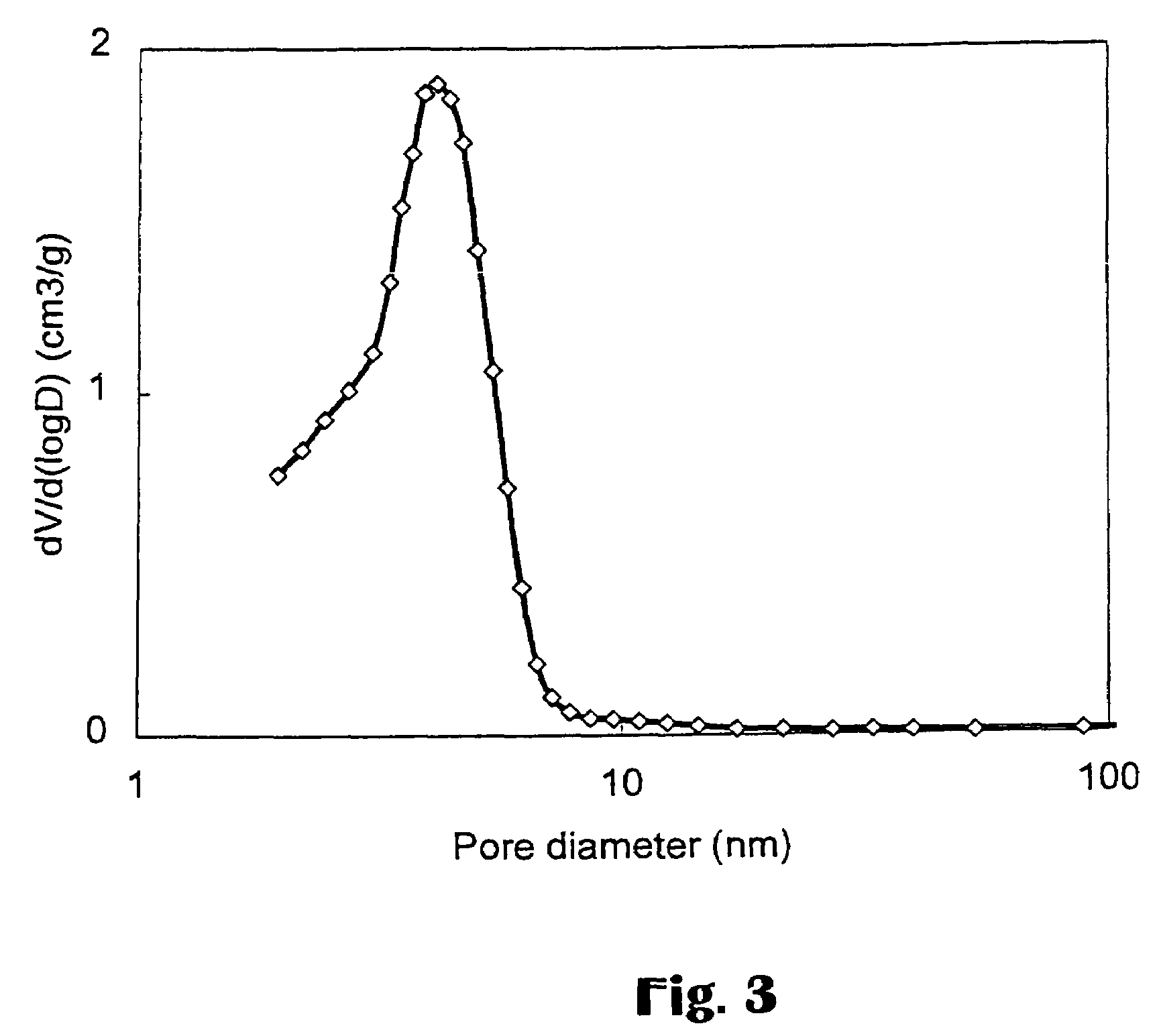Mesoporous material with active metals
a technology of active metals and porous materials, applied in the direction of catalyst activation/preparation, metal/metal-oxide/metal-hydroxide catalysts, etc., can solve the problem of moderately effective heteroatom dispersion
- Summary
- Abstract
- Description
- Claims
- Application Information
AI Technical Summary
Benefits of technology
Problems solved by technology
Method used
Image
Examples
example 1
[0068]This example shows how to incorporate aluminum into silica without heating in an autoclave before calcination.
[0069]First, 1 part aluminum isopropoxide (Al(iso—OC3H6)3) was added into 26 parts of an aqueous solution of tetraethylammonium hydroxide (TEAOH, 35%) while stirring. After dissolution, 38 parts of triethanolamine (TEA) together with 8 parts of water were added into the above solution under stirring. Then, 26 parts of tetraethyl orthosilicate (TEOS) were added under vigorous stirring. A clear solution was obtained. The stirring was continued for 1 hour, and then the synthesis mixture was aged at room temperature overnight and dried at 98 C in air for 24 hours. Finally, the synthesis mixture was calcined at 570° C. for 10 hours in air with a ramp rate of 1° C. / min.
[0070]FIG. 1 shows its XRD pattern with an intensive reflection at about 1.1° in 2 theta (θ), indicating the characteristic of a mesoporous material. In addition, the absence of resolved peaks for alumina impl...
example 2
[0071]This example demonstrates the incorporation of heteroatoms with heating in an autoclave before calcination. 3.3 Parts of aluminum isopropoxide were added into a bottle with 42 parts of TEOS and stirred for an hour. A mixture of 7.6 parts of TEA and 25.8 parts of water were added into the mixture of TEOS and Al(iso-OC3H6)3 under stirring. After 2 hours stirring, 21 parts of TEAOH were drop-wise added into the above mixture and a thick gel formed. The gel was dried in an oven at 98° C. for 22 hours and then transferred into an autoclave at 190° C. for 16 hours. Finally the gel was calcined at 600° C. for 10 hours in air.
[0072]FIG. 4 shows its XRD pattern with an intensive reflection at a low angle in 2 theta (θ), indicating the characteristic of mesoporous material. Elemental analysis showed its Si / Al ratio of about 24.5, consistent with the ratio of initial synthesis mixture was 25. Nitrogen adsorption revealed a surface area of 799 m2 / g, a total pore volume of 1.24 cm3 / g and a...
example 3a
[0073]This demonstrates the incorporation of aluminum and its stability of the composition. 3 Parts of aluminum isopropoxide were added into a bottle with 38.8 parts of TEOS and stirred for 1.5 hours. A mixture of 23 parts of TEA and 21 parts of water was added into the above mixture under stirring. After 2 hours stirring, 23 parts of TEAOH were drop-wise added into the above mixture and after 0.5 hours stirring it turned into a clear solution. The solution was dried in an oven at 100° C. for 4 days and then transferred into an autoclave at 190° C. for 7.5 days. Finally it was calcined at 600° C. for 10 hours with a ramp rate of 1° C. / min in air.
[0074]Elemental analysis showed the Si / Al ratio to be 99.2. FIG. 5 shows its XRD pattern with an intensive peak. Nitrogen adsorption shows a narrow pore size distribution centered at 17 nm, as presented in FIG. 6, which exhibited a surface area of about 385 m2 / g, and a pore volume of about 1.32 cm3 / g.
PUM
| Property | Measurement | Unit |
|---|---|---|
| temperature | aaaaa | aaaaa |
| temperature | aaaaa | aaaaa |
| pressure | aaaaa | aaaaa |
Abstract
Description
Claims
Application Information
 Login to View More
Login to View More - R&D
- Intellectual Property
- Life Sciences
- Materials
- Tech Scout
- Unparalleled Data Quality
- Higher Quality Content
- 60% Fewer Hallucinations
Browse by: Latest US Patents, China's latest patents, Technical Efficacy Thesaurus, Application Domain, Technology Topic, Popular Technical Reports.
© 2025 PatSnap. All rights reserved.Legal|Privacy policy|Modern Slavery Act Transparency Statement|Sitemap|About US| Contact US: help@patsnap.com



